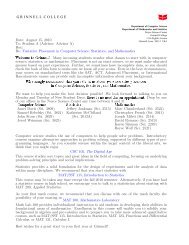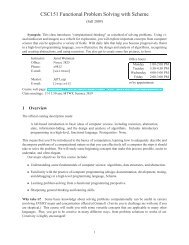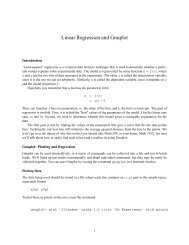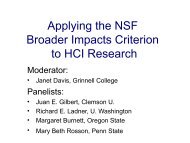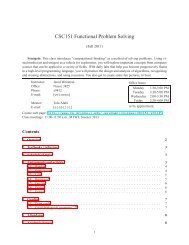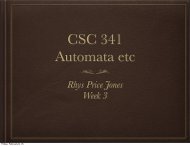sign detection in natural images with conditional random fields
sign detection in natural images with conditional random fields
sign detection in natural images with conditional random fields
You also want an ePaper? Increase the reach of your titles
YUMPU automatically turns print PDFs into web optimized ePapers that Google loves.
Appear<strong>in</strong>g <strong>in</strong> IEEE International Workshop on Mach<strong>in</strong>e Learn<strong>in</strong>g for Signal<br />
Process<strong>in</strong>g, São Luís, Brazil, Sep. 2004.<br />
SIGN DETECTION IN NATURAL IMAGES<br />
WITH CONDITIONAL RANDOM FIELDS<br />
Jerod We<strong>in</strong>man, Allen Hanson, and Andrew McCallum<br />
{we<strong>in</strong>man,hanson,mccallum}@cs.umass.edu<br />
Department of Computer Science<br />
University of Massachusetts-Amherst<br />
Abstract. Traditional generative Markov <strong>random</strong> <strong>fields</strong> for segment<strong>in</strong>g<br />
<strong>images</strong> model the image data and correspond<strong>in</strong>g labels<br />
jo<strong>in</strong>tly, which requires extensive <strong>in</strong>dependence assumptions for tractability.<br />
We present the <strong>conditional</strong> <strong>random</strong> field for an application<br />
<strong>in</strong> <strong>sign</strong> <strong>detection</strong>, us<strong>in</strong>g typical scale and orientation selective texture<br />
filters and a nonl<strong>in</strong>ear texture operator based on the grat<strong>in</strong>g<br />
cell. The result<strong>in</strong>g model captures dependencies between neighbor<strong>in</strong>g<br />
image region labels <strong>in</strong> a data-dependent way that escapes the<br />
difficult problem of model<strong>in</strong>g image formation, <strong>in</strong>stead focus<strong>in</strong>g effort<br />
and computation on the label<strong>in</strong>g task. We compare the results<br />
of tra<strong>in</strong><strong>in</strong>g the model <strong>with</strong> pseudo-likelihood aga<strong>in</strong>st an approximation<br />
of the full likelihood <strong>with</strong> the iterative tree reparameterization<br />
algorithm and demonstrate improvement over previous methods.<br />
INTRODUCTION<br />
Image segmentation and region label<strong>in</strong>g are common problems <strong>in</strong> computer<br />
vision. In this work, we seek to identify <strong>sign</strong>s <strong>in</strong> <strong>natural</strong> <strong>images</strong> by classify<strong>in</strong>g<br />
regions accord<strong>in</strong>g to their textural properties. Our goal is to <strong>in</strong>tegrate <strong>with</strong> a<br />
wearable system that will recognize any detected <strong>sign</strong>s as a navigational aid<br />
to the visually impaired. Generic <strong>sign</strong> <strong>detection</strong> is a difficult problem. Signs<br />
may be located anywhere <strong>in</strong> an image, exhibit a wide range of sizes, and<br />
conta<strong>in</strong> an extraord<strong>in</strong>arily broad set of fonts, colors, arrangements, etc. For<br />
these reasons, we treat <strong>sign</strong>s as a general texture class and seek to discrim<strong>in</strong>ate<br />
such a class from the many others present <strong>in</strong> <strong>natural</strong> <strong>images</strong>.<br />
The value of context <strong>in</strong> computer vision tasks has been studied <strong>in</strong> various<br />
ways for many years. Two types of context are important for this problem:<br />
label context and data context. In the absence of label context, local regions<br />
are classified <strong>in</strong>dependently, which is a common approach to object <strong>detection</strong>.<br />
Such disregard for the (unknown) labels of neighbor<strong>in</strong>g regions often leads to<br />
isolated false positives and miss<strong>in</strong>g false negatives. The absence of data context<br />
means ignor<strong>in</strong>g potentially helpful image data from any neighbors of the
egion be<strong>in</strong>g classified. Both contexts are simultaneously important. For <strong>in</strong>stance,<br />
s<strong>in</strong>ce neighbor<strong>in</strong>g regions often have the same label, we could penalize<br />
label discont<strong>in</strong>uity <strong>in</strong> an image. If such regularity is imposed <strong>with</strong>out regard<br />
for the actual data <strong>in</strong> a region and local evidence for a label is weak, then<br />
cont<strong>in</strong>uity constra<strong>in</strong>ts would typically override the local data. Conversely,<br />
local region evidence for a “<strong>sign</strong>” label could be weak, but a strong edge <strong>in</strong><br />
the adjo<strong>in</strong><strong>in</strong>g region might bolster belief <strong>in</strong> the presence of a <strong>sign</strong> at the site<br />
because the edge <strong>in</strong>dicates a transition. Thus, consider<strong>in</strong>g both the labels<br />
and data of neighbor<strong>in</strong>g regions is important for predict<strong>in</strong>g labels. This is<br />
exactly what the <strong>conditional</strong> <strong>random</strong> field (CRF) model provides.<br />
The advantage of the discrim<strong>in</strong>ative contextual model over a generative<br />
one for <strong>detection</strong> tasks has recently been shown <strong>in</strong> [8]. We demonstrate a<br />
tra<strong>in</strong><strong>in</strong>g method that improves prediction results, and we apply the model<br />
to a challeng<strong>in</strong>g real-world task. First the details of the model and how it<br />
differs from the typical <strong>random</strong> field are described, followed by a description<br />
of the image features we use. We close <strong>with</strong> experiments and conclusions.<br />
RANDOM FIELDS<br />
Model<br />
For many computer vision tasks, the prior probability of the data be<strong>in</strong>g observed<br />
is <strong>in</strong>consequential. Images happen. We are primarily <strong>in</strong>terested <strong>in</strong><br />
what may be <strong>in</strong>ferred when given the <strong>images</strong>. However, probability distributions<br />
over labels y and an image x have traditionally been modeled jo<strong>in</strong>tly,<br />
<strong>with</strong> the image prior probability be<strong>in</strong>g ignored at classification time. For that<br />
reason, generative jo<strong>in</strong>t models require unnecessary model<strong>in</strong>g effort and more<br />
computation than their <strong>conditional</strong> counterparts.<br />
Markov <strong>random</strong> <strong>fields</strong> are probability distributions parameterized by a<br />
graph topology G = (V, E). For tractability reasons, typical generative <strong>random</strong><br />
<strong>fields</strong> treat the <strong>in</strong>teraction between local data and its label <strong>in</strong>dependently<br />
of the <strong>in</strong>teraction between neighbor<strong>in</strong>g labels. The jo<strong>in</strong>t distribution is thus<br />
factored <strong>in</strong>to the prior on label as<strong>sign</strong>ments and the probability of locally<br />
observed data, conditioned on the s<strong>in</strong>gle site label:<br />
p (y, x) = p (x | y) p (y) 1 ∏<br />
ψ C (y C ) ∏ ψ v (y v , x v ) , (1)<br />
Z<br />
C∈C v∈V<br />
where ψ (·) are compatibility functions, Z is a normaliz<strong>in</strong>g constant mak<strong>in</strong>g<br />
the expression a probability distribution, C is a family of cliques of the graph,<br />
and y C are the variables <strong>in</strong> a given clique C ⊂ V . In this model, objects x<br />
(e.g., patch statistics, salient features, etc.) from each class y ∈ Y are generated<br />
by a class-<strong>conditional</strong> probability distribution p (x | y). This requires not<br />
only a model for every class we wish to dist<strong>in</strong>guish, but an accurate generative<br />
background model even for classes of no <strong>in</strong>terest; a non-trivial task because<br />
the real world conta<strong>in</strong>s a myriad of image “classes” (region types, textures,
x 1<br />
x 3<br />
x 4<br />
x 2<br />
y 3 y 4<br />
x<br />
y3 y4<br />
y 1<br />
y 2<br />
y1 y2<br />
Figure 1: Left: Traditional jo<strong>in</strong>t <strong>random</strong> field over data x and labels y (cf. Eq.<br />
1). Right: Conditional <strong>random</strong> field where data is observed (cf. Eq. 2).<br />
objects, etc.). In short, it is generally more difficult to expla<strong>in</strong> the processes<br />
that generate class data than it is to model the boundaries between classes.<br />
In the latter approach, only boundaries among classes of <strong>in</strong>terest must be dist<strong>in</strong>guished,<br />
<strong>with</strong> the rema<strong>in</strong>der easily collaps<strong>in</strong>g <strong>in</strong>to a s<strong>in</strong>gle “background”<br />
class. Model<strong>in</strong>g the <strong>in</strong>teractions between data and labels separately, as (1)<br />
does, is often too limit<strong>in</strong>g for many computer vision tasks; we therefore use<br />
a recently proposed model that handles the <strong>in</strong>teraction between site labels <strong>in</strong><br />
a context-dependent way [9], describ<strong>in</strong>g it next.<br />
The <strong>random</strong> field graph topology commonly used for jo<strong>in</strong>t image label<strong>in</strong>g<br />
problems is the lattice, (Figure 1), where cliques are s<strong>in</strong>gle nodes and edges.<br />
We use a homogeneous, anisotropic <strong>random</strong> field. Thus, cliques of the same<br />
class use the same compatibility functions regardless of image location, but<br />
horizontal and vertical edges are considered different classes and thus have<br />
dist<strong>in</strong>ct compatibility functions. Anisotropy allows the model to learn any<br />
orientational bias of the labels. Our <strong>conditional</strong> <strong>random</strong> field has the form<br />
p (y | x) =<br />
=<br />
1<br />
Z (x)<br />
∏<br />
ψ V (y v , x)<br />
v∈V<br />
⎛<br />
1<br />
Z (x) exp ⎝ ∑ v∈V<br />
∏<br />
(u,v)∈E<br />
λ · F (y v , x) +<br />
ψ E (y u , y v , x) (2)<br />
∑<br />
(u,v)∈E<br />
⎞<br />
µ · G (y u , y v , x) ⎠ ,(3)<br />
where Z is now an observation-dependent normalizer. The compatibilities are<br />
functions of clique labels, allow<strong>in</strong>g neighbor<strong>in</strong>g label <strong>in</strong>teraction, but they are<br />
also functions of the entire observation. This differs markedly from (1) by<br />
allow<strong>in</strong>g data-dependent label <strong>in</strong>teraction (see Figure 1). F and G are vectorvalued<br />
feature functions, and λ and µ are vectors of parameters for nodes<br />
and edges, respectively. Node labels come from a discrete, f<strong>in</strong>ite alphabet Y.<br />
We use one set of observation features for nodes and edges and transform<br />
them <strong>in</strong>to feature functions (observation, label pairs) us<strong>in</strong>g the relationship<br />
f k y (y v , x) = δ (y, y v ) f k (x)<br />
g j y,y ′ (y u, y v , x) = δ (y, y u ) δ (y ′ , y v ) g j (x) ,<br />
where f = ( f k) is a vector of node features (i.e., texture statistics of<br />
k=1...K
a region) and g = ( g j) is a vector of edge features (i.e., differences<br />
j=1...J<br />
between statistics of neighbor<strong>in</strong>g regions), so that F = ( )<br />
fy<br />
k )<br />
and<br />
k=1...K,y∈Y<br />
G =<br />
(g j y,y<br />
. Thus λ ∈ R K|Y| and µ ∈ R ′ J|Y|2 . When E =<br />
j=1...J,y,y ′ ∈Y×Y<br />
∅, the model uses no label context and is commonly called a <strong>conditional</strong><br />
maximum entropy classifier (hence, MaxEnt), or logistic regression.<br />
Tra<strong>in</strong><strong>in</strong>g and Inference<br />
Parameters for probabilistic models like CRFs are generally set by maximiz<strong>in</strong>g<br />
the likelihood of a data sample. Unfortunately, <strong>in</strong>ference for any <strong>random</strong><br />
field <strong>with</strong> the lattice topology is <strong>in</strong>tractable due to Z (an exponential sum).<br />
Markov cha<strong>in</strong> Monte Carlo (MCMC) (see e.g., [16]) is often used to approximate<br />
Z <strong>in</strong> similar generative models. However, <strong>in</strong> our <strong>conditional</strong> model Z is<br />
dependent on the image data x and must be estimated for each observation<br />
<strong>in</strong> the sample. A simpler approximation is to maximize the pseudo-likelihood<br />
(PL) [1], which is the product of the probabilities of nodes given their neighbor<strong>in</strong>g<br />
labels. The normalizers are then summations over labels at a s<strong>in</strong>gle<br />
node, rather than the possible label<strong>in</strong>gs of all nodes.<br />
A relatively new alternative to MCMC and PL for approximat<strong>in</strong>g likelihood<br />
is called tree reparameterization (TRP) [15]. Inference <strong>in</strong> graphical<br />
models <strong>with</strong>out cycles (unlike the lattice) is very efficient, i.e., due to the<br />
junction tree algorithm (e.g., [10]). An important consequence of the junction<br />
tree algorithm is that marg<strong>in</strong>al distributions are revealed on pairs of<br />
neighbor<strong>in</strong>g nodes, <strong>in</strong>duc<strong>in</strong>g an alternative factorization of the jo<strong>in</strong>t distribution.<br />
TRP operates by us<strong>in</strong>g junction tree to compute the exact marg<strong>in</strong>als on<br />
a spann<strong>in</strong>g tree of the cyclic graph. The spann<strong>in</strong>g tree’s factorization is then<br />
placed back <strong>in</strong>to the orig<strong>in</strong>al graph, and the process repeats <strong>with</strong> different<br />
spann<strong>in</strong>g trees until the parameterization converges, leav<strong>in</strong>g the marg<strong>in</strong>als.<br />
We demonstrate improved <strong>detection</strong> performance us<strong>in</strong>g TRP to approximate<br />
the likelihood over pseudo-likelihood. The likelihood function is convex and<br />
may be optimized globally via gradient ascent. Pseudo-likelihood is sensitive<br />
to <strong>in</strong>itialization, however, so node parameters are optimized first. We use the<br />
quasi-newton L-BFGS algorithm for maximization.<br />
To prevent tra<strong>in</strong><strong>in</strong>g procedures from overfitt<strong>in</strong>g parameters <strong>in</strong> <strong>conditional</strong><br />
models, a prior is <strong>in</strong>troduced, and the posterior is maximized rather than<br />
likelihood. We employ a diagonal zero-centered Gaussian prior on parameters<br />
[2] (similar to weight decay <strong>in</strong> neural networks or ridge regression); variances<br />
are experimentally determ<strong>in</strong>ed through cross-validation.<br />
Given the image data, our model simply yields a jo<strong>in</strong>t posterior distribution<br />
on label<strong>in</strong>gs. When <strong>in</strong>terested <strong>in</strong> pick<strong>in</strong>g a hard and fast label for each<br />
region of the image (node <strong>in</strong> the graph), the question becomes what to do<br />
<strong>with</strong> that distribution. A simple, oft-used answer is to f<strong>in</strong>d its maximum.<br />
That is, use maximum a posteriori (MAP) estimation:<br />
ŷ = arg max<br />
y∈Y |V | p (y | x) .
This search space is <strong>in</strong>tractable. However, a slight alteration of TRP allows<br />
MAP estimates to be quickly calculated. A simpler alternative is to search<br />
for a local maximum of the posterior, an estimate called iterated <strong>conditional</strong><br />
modes (ICM). Given some <strong>in</strong>itial label<strong>in</strong>g y 0 , subsequent labels are given by<br />
y k+1<br />
v<br />
(<br />
)<br />
= arg max p y v | yN k (v) , x , ∀v ∈ V<br />
y v∈Y<br />
until y k+1 = y k or an iteration limit is exceeded. Often, the <strong>in</strong>itial label<strong>in</strong>g<br />
comes from the local compatibility maximum y 0 v = arg max yv∈Y ψ (y v , x) .<br />
Like many po<strong>in</strong>t estimates, the MAP estimation has an important caveat:<br />
poor predictions can result when the maximum of the posterior is not representative<br />
of most of the other likely label<strong>in</strong>gs [6]. An alternative method for<br />
prediction is called maximum posterior marg<strong>in</strong>al (MPM) estimation,<br />
ŷ v = arg max<br />
y v∈Y p (y v | x) , ∀v ∈ V,<br />
which accounts for the probability of all label<strong>in</strong>gs, not simply the maximal<br />
(jo<strong>in</strong>t) label<strong>in</strong>g, by choos<strong>in</strong>g the label at each node that maximizes its<br />
marg<strong>in</strong>al probability. MAP and MPM are equivalent <strong>in</strong> the MaxEnt classifier<br />
s<strong>in</strong>ce node labels are <strong>in</strong>dependent. Marg<strong>in</strong>alization suffers from the same<br />
computational complexity problems as MAP, but s<strong>in</strong>ce TRP reveals (approximate)<br />
marg<strong>in</strong>als on the nodes, it is easily used for MPM. Comparisons<br />
between ICM and MAP estimated <strong>with</strong> TRP are given <strong>in</strong> the experiments.<br />
IMAGE FEATURES FOR SIGN DETECTION<br />
Text and <strong>sign</strong> <strong>detection</strong> has been the subject of much research. Earlier approaches<br />
either use <strong>in</strong>dependent, local classifications (i.e., [5, 7, 11]) or use<br />
heuristic methods, such as connected component analysis (i.e., [4, 14]). Much<br />
work has been based on edge detectors or more general texture features, as<br />
well as color. Our approach calculates a jo<strong>in</strong>t label<strong>in</strong>g of image patches,<br />
rather than label<strong>in</strong>g patches <strong>in</strong>dependently, and it obviates layout heuristics<br />
by allow<strong>in</strong>g the CRF to learn the characteristics of regions that conta<strong>in</strong> text.<br />
Rather than simply us<strong>in</strong>g functions of s<strong>in</strong>gle filters (e.g., moments) or edges,<br />
we use a richer representation that captures important relationships between<br />
responses to different scale- and orientation-selective filters.<br />
To measure the general textural properties of both <strong>sign</strong> and especially<br />
non-<strong>sign</strong> (hence, background) image regions, we use responses of scale and orientation<br />
selective filters. Specifically, we use the statistics of filter responses<br />
described <strong>in</strong> [13], where correlations between steerable pyramid responses of<br />
different scales and orientations are the prom<strong>in</strong>ent features.<br />
A biologically <strong>in</strong>spired non-l<strong>in</strong>ear texture operator for detect<strong>in</strong>g grat<strong>in</strong>gs<br />
of bars at a particular orientation and scale is described <strong>in</strong> [12]. Scale and<br />
orientation selective filters, such as the steerable pyramid or Gabor filters,<br />
respond <strong>in</strong>discrim<strong>in</strong>ately to both s<strong>in</strong>gle edges and one or more bars. Grat<strong>in</strong>g
I<br />
T<br />
F<br />
F<br />
R<br />
MMMMMM<br />
Q<br />
P<br />
Primary<br />
Simple<br />
Filters<br />
Secondary<br />
Orthogonal<br />
Filter<br />
Weighted<br />
Simple<br />
Filters<br />
Receptive<br />
Field<br />
Maximums<br />
Grat<strong>in</strong>g<br />
AND−like<br />
Indicator<br />
F<strong>in</strong>al<br />
Grat<strong>in</strong>g<br />
Response<br />
Figure 2: Grat<strong>in</strong>g cell data flow for a s<strong>in</strong>gle scale and orientation. Two boxes at<br />
I, T , and F represent center on and center off filters, while the boxes at M are for<br />
the six receptive <strong>fields</strong>.<br />
cells, on the other hand, respond selectively only to multiple (three or more)<br />
bars. This property is an ideal match for detect<strong>in</strong>g text, which is generally<br />
characterized by a “grat<strong>in</strong>g” of strokes. The orig<strong>in</strong>al model is contrastnormalized,<br />
but we expect text <strong>in</strong> <strong>sign</strong>s to have high contrast for readability,<br />
so we omit any normalization when calculat<strong>in</strong>g I θ,ω,φ , the response of an <strong>in</strong>put<br />
image to a filter <strong>with</strong> preferred orientation θ, spatial frequency ω, and<br />
phase φ (Figure 3, upper-right). Furthermore, letters have a limited aspect<br />
ratio, thus the bars <strong>in</strong> text have bounded height. For this reason we subject<br />
the responses I θ,ω,φ to a second round of filter<strong>in</strong>g <strong>with</strong> output T θ,ω,φ , where<br />
θ, ω, φ still <strong>in</strong>dicates the parameters of the primary simple filter. The secondary<br />
filter has an orthogonal orientation θ + π 2<br />
, a center-on phase of π, and<br />
should have a frequency of no more than ω/ 2. To elicit stronger responses<br />
from bars of limited height, the orig<strong>in</strong>al simple filter response is weighted by<br />
the perpendicular response <strong>with</strong> the Schur product F θ,ω,φ I θ,ω,φ ◦ T θ,ω,φ .<br />
Once the weighted responses are calculated, a b<strong>in</strong>ary grat<strong>in</strong>g cell subunit<br />
Q θ,ω <strong>in</strong>dicates the presence of a grat<strong>in</strong>g at each image location. To make<br />
such a determ<strong>in</strong>ation, alternat<strong>in</strong>g strong maximum center-on (φ = π) and<br />
center-off (φ = 0) responses M θ,ω,n are required <strong>in</strong> receptive field regions<br />
R θ,ω,n (−3 ≤ n ≤ 2) of length 1/ (2ω) along a l<strong>in</strong>e <strong>with</strong> orientation θ (Figure<br />
3, bottom). We let the f<strong>in</strong>al output P θ,ω be the mean response among the<br />
receptive <strong>fields</strong> where Q θ,ω <strong>in</strong>dicates a grat<strong>in</strong>g and zero elsewhere. This also<br />
differs from the orig<strong>in</strong>al model, which simply gives the spatial average of the<br />
grat<strong>in</strong>g <strong>in</strong>dicator. Use of actual filter responses <strong>in</strong> the output is important<br />
because it represents the strength of the grat<strong>in</strong>g, rather than only its presence.<br />
After tak<strong>in</strong>g maximum responses over a set of scales, we use the mean,<br />
max, variance, skew and kurtosis of the outputs <strong>in</strong> a region as features.<br />
Additionally, histograms of patch hue and saturation are used, which also<br />
allows us to measure color discont<strong>in</strong>uities between patches.<br />
Us<strong>in</strong>g an algorithm [3] that ranks discrim<strong>in</strong>ative power of <strong>random</strong> field<br />
model features, we found the top three <strong>in</strong> the edge-less, context-free MaxEnt<br />
model to be (i) the level of green hue (easily identify<strong>in</strong>g vegetation as background),<br />
(ii) mean grat<strong>in</strong>g cell response (easily identify<strong>in</strong>g text), and (iii)<br />
correlation between a vertically and diagonally oriented filter of moderate<br />
scale (the s<strong>in</strong>gle most useful other ‘textural’ feature).
Figure 3: Grat<strong>in</strong>g operator on text. Upper Left: Input image. Upper Right:<br />
Center-on and center-off simple filter responses (θ = 0). Bottom: Slice of simple<br />
filter responses and receptive regions for a marked po<strong>in</strong>t.<br />
Figure 4: Multi-scale text <strong>detection</strong> <strong>with</strong> grat<strong>in</strong>g cells. Left: Input image <strong>with</strong><br />
<strong>sign</strong> areas outl<strong>in</strong>ed. Right: Grat<strong>in</strong>g cell responses.<br />
EXPERIMENTS<br />
Our <strong>sign</strong> experiments are based on a hand-labeled database of 309 <strong>images</strong><br />
collected from a North American downtown area <strong>with</strong> a still camera. 1 We<br />
view the 1024x768 pixel <strong>images</strong> as an 8x6 grid of 128x128 pixel patches over<br />
which the features are computed. This outer scale was chosen to balance<br />
computational burden aga<strong>in</strong>st typical <strong>sign</strong> size; some patches conta<strong>in</strong> more<br />
<strong>sign</strong> than others. Let f p represent the statistics of the steerable pyramid, f g<br />
the grat<strong>in</strong>g statistics, and f h , f s the hue and saturation histograms, respectively.<br />
Our node features are the concatenated vectors f = 〈f p , f g , f h , f s , 1〉<br />
1 Available at .
Classifier Prediction Recall Precision F1<br />
MaxEnt MAP 48.36 68.02 56.45<br />
ICM 49.42 70.23 57.90<br />
PL MAP 49.53 70.23 57.97<br />
CRF<br />
MPM 49.97 69.77 58.13<br />
ICM 54.01 66.54 59.49<br />
TRP MAP 54.58 66.07 59.57<br />
MPM 54.58 66.07 59.65<br />
Table 1: Prediction results for <strong>sign</strong>s. PL <strong>in</strong>dicates tra<strong>in</strong><strong>in</strong>g <strong>with</strong><br />
pseudo-likelihood, and TRP tra<strong>in</strong><strong>in</strong>g <strong>with</strong> approximated full likelihood.<br />
MAP and MPM for the CRF is estimated <strong>with</strong> TRP.<br />
1<br />
1<br />
0.8<br />
0.8<br />
Detection Rate<br />
0.6<br />
0.4<br />
Detection Rate<br />
0.6<br />
0.4<br />
0.2<br />
50%− 75% : 0.9091<br />
75%−100% : 0.9589<br />
0.2<br />
MaxEnt : 0.7061<br />
CRF : 0.7416<br />
0<br />
0 0.2 0.4 0.6 0.8 1<br />
False Alarm Rate<br />
0<br />
0 0.2 0.4 0.6 0.8 1<br />
False Alarm Rate<br />
Figure 5: Discrim<strong>in</strong>ative power. Left: ROC curves and areas for MaxEnt on<br />
patches that are nearly all (75%-100%) <strong>sign</strong> or mostly (50-75%) <strong>sign</strong>. Right: ROC<br />
curves and areas for MaxEnt and CRF <strong>in</strong> patches conta<strong>in</strong><strong>in</strong>g less than 25% <strong>sign</strong>.<br />
plus a bias feature. Edge features are the L2 norms of differences between<br />
statistics at neighbor<strong>in</strong>g patches, g = 〈∥ ∥ fp − f p<br />
′ ∥ , ‖fh − f<br />
h ′ ‖ , ‖f s − f s‖ ′ , 1 〉 .<br />
The image set is split evenly <strong>with</strong> half each for tra<strong>in</strong><strong>in</strong>g and test<strong>in</strong>g. Table<br />
1 conta<strong>in</strong>s the average prediction results of 20 such splits. S<strong>in</strong>ce this<br />
is a <strong>detection</strong> task, we report precision and recall (common <strong>in</strong> <strong>in</strong>formation<br />
retrieval) for each prediction method. Let D S be the number of true <strong>sign</strong><br />
patches detected <strong>with</strong> D the total number of <strong>detection</strong>s and S the actual<br />
number of true <strong>sign</strong> patches. Precision is P = D S / D, the percentage of<br />
<strong>detection</strong>s that are correct (not the complement of false alarm). Recall is<br />
R = D S / S, the <strong>detection</strong> rate. The harmonic mean of recall and precision<br />
F 1 = 2P R/ (P + R) reflects the balance (or lack thereof) between the rate<br />
and accuracy of <strong>detection</strong>s; higher F1 <strong>in</strong>dicates better overall performance.<br />
MAP and ICM are po<strong>in</strong>t estimates of the unwieldy jo<strong>in</strong>t posterior probability,<br />
but the marg<strong>in</strong>al posterior of a label (i.e., “<strong>sign</strong>”) at a node is a real<br />
quantity that may be easily varied. Figure 5 (left) demonstrates that overall<br />
discrim<strong>in</strong>ation is very good even <strong>in</strong> the context-free MaxEnt classifier when
Figure 6: Example <strong>detection</strong> results. Left-Right: MaxEnt, CRF ICM and MAP.<br />
a patch conta<strong>in</strong>s nearly all <strong>sign</strong>, but performance degrades as the amount of<br />
<strong>sign</strong> <strong>in</strong> a patch decreases. Figure 5 (right) shows that add<strong>in</strong>g context <strong>with</strong> a<br />
CRF improves the ability to identify all regions of a <strong>sign</strong>, especially those on<br />
the border where the patch conta<strong>in</strong>s more background.<br />
Us<strong>in</strong>g a CRF <strong>sign</strong>ificantly improves F1 over the local MaxEnt classifier. 2<br />
Tra<strong>in</strong><strong>in</strong>g <strong>with</strong> TRP also improves recall. Because it is given true neighbor<strong>in</strong>g<br />
labels, which are unavailable at test time, PL tra<strong>in</strong><strong>in</strong>g tends to be overconfident<br />
<strong>with</strong> edge parameters, lead<strong>in</strong>g to higher precision (except<strong>in</strong>g MPM)<br />
as a result of over-smooth<strong>in</strong>g the labels. TRP tra<strong>in</strong><strong>in</strong>g yields higher F1 and<br />
recall over PL for all prediction methods.<br />
CONCLUSIONS<br />
The <strong>conditional</strong> <strong>random</strong> field is a powerful new model for vision applications<br />
that does not require the strong <strong>in</strong>dependence assumptions of generative<br />
models. With it, we demonstrate <strong>sign</strong> <strong>detection</strong> <strong>in</strong> <strong>natural</strong> <strong>images</strong> us<strong>in</strong>g<br />
both general texture features and special features for text. Add<strong>in</strong>g context<br />
<strong>in</strong>creases the <strong>detection</strong> rate faster than the false alarm rate by draw<strong>in</strong>g on<br />
both observed data and unknown labels from neighbor<strong>in</strong>g regions.<br />
The complexity issues of cyclic <strong>random</strong> <strong>fields</strong> are well known. Although<br />
tra<strong>in</strong><strong>in</strong>g times are greater, prediction <strong>with</strong> a CRF still only requires about 3<br />
seconds on a 3GHz desktop workstation. We have shown the superiority of<br />
tree reparameterization over the pseudo-likelihood approximation for parameter<br />
estimation and prediction <strong>in</strong> the CRF model for our <strong>detection</strong> task.<br />
We plan to add more edge features to <strong>in</strong>crease our use of the model’s<br />
contextual power by <strong>in</strong>corporat<strong>in</strong>g feature selection and <strong>in</strong>duction methods.<br />
Overfitt<strong>in</strong>g rema<strong>in</strong>s a constant problem <strong>in</strong> such a high-dimensional model, so<br />
regularization is an important area for study.<br />
Acknowledgments<br />
Thanks to Aron Culotta, Khashayar Rohanimanesh, and Charles Sutton for their assistive<br />
discussions. This work was supported <strong>in</strong> part by NFS grant #IIS-0100851, <strong>in</strong> part by<br />
the Center for Intelligent Information Retrieval, and <strong>in</strong> part by The Central Intelligence<br />
Agency, the National Security Agency and National Science Foundation under NSF grant<br />
#IIS-0326249.<br />
2 Claims of relative performance are based on a two-sided, paired <strong>sign</strong> test (p < 4e − 5).
References<br />
[1] J. Besag, “Statistical analysis of non-lattice data,” The Statistician, vol. 24,<br />
no. 3, pp. 179–195, 1975.<br />
[2] S. Chen and R. Rosenfeld, “A Gaussian prior for smooth<strong>in</strong>g maximum entropy<br />
models,” Techn. Report CMU-CS-99-108, Carnegie Mellon University,<br />
1999.<br />
[3] S. Della Pietra, V. Della Pietra and J. Lafferty, “Induc<strong>in</strong>g Features of Random<br />
Fields,” IEEE Transactions on Pattern Analysis and Mach<strong>in</strong>e<br />
Intelligence, vol. 19, no. 4, pp. 380–393, 1997.<br />
[4] J. Gao and J. Yang, “An Adaptive Algorithm for Text Detection from Natural<br />
Scenes,” <strong>in</strong> Proceed<strong>in</strong>gs of the 2001 IEEE Conference on Computer<br />
Vision and Pattern Recognition, December 2001, vol. 2, pp. 84–89.<br />
[5] C. Garcia and X. Apostolidis, “Text Detection and Segmentation <strong>in</strong> Complex<br />
Color Images,” <strong>in</strong> Proceed<strong>in</strong>gs of 2000 IEEE International Conference<br />
on Acoustics, Speech and Signal Process<strong>in</strong>g (ICASSP2000), June<br />
2000, vol. 4, pp. 2326–2330.<br />
[6] D. Grieg, B. Porteous and A. Seheult, “Exact maximum a posteriori estimation<br />
for b<strong>in</strong>ary <strong>images</strong>,” Journal of the Royal Statistical Society, vol. 51, no. 2,<br />
pp. 271–279, 1989.<br />
[7] A. Ja<strong>in</strong> and S. Bhattacharjee, “Text segmentation us<strong>in</strong>g Gabor filters for automatic<br />
document process<strong>in</strong>g,” Mach<strong>in</strong>e Vision Applications, vol. 5, pp. 169–<br />
184, 1992.<br />
[8] S. Kumar and M. Hebert, “Discrim<strong>in</strong>ative Random Fields: A Discrim<strong>in</strong>ative<br />
Framework for Contextual Interaction <strong>in</strong> Classification,” <strong>in</strong> Proc. 2003<br />
IEEE International Conference on Computer Vision (ICCV ’03),<br />
2003, vol. 2, pp. 1150–1157.<br />
[9] J. Lafferty, A. McCallum and F. Pereira, “Conditional Random Fields: Probabilistic<br />
Models for Segment<strong>in</strong>g and Label<strong>in</strong>g Sequence Data,” <strong>in</strong> Proc. 18th<br />
International Conference on Mach<strong>in</strong>e Learn<strong>in</strong>g, Morgan Kaufmann,<br />
San Francisco, CA, 2001, pp. 282–289.<br />
[10] S. L. Lauritzen, Graphical Models, no. 17 <strong>in</strong> Oxford Statistical Science<br />
Series, Clarendon, 1996.<br />
[11] H. Li, D. Doermann and O. Kia, “Automatic Text Detection and Track<strong>in</strong>g <strong>in</strong><br />
Digital Video,” IEEE Transactions on Image Process<strong>in</strong>g, vol. 9, no. 1,<br />
pp. 147–156, 2000.<br />
[12] N. Petkov and P. Kruiz<strong>in</strong>ga, “Computational model of visual neurons specialised<br />
<strong>in</strong> the <strong>detection</strong> of period and aperiodic oriented visual stimuli: bar<br />
and grat<strong>in</strong>g cells,” Biological Cybernetics, vol. 76, pp. 83–96, 1997.<br />
[13] J. Portilla and E. P. Simoncelli, “A parametric texture model based on jo<strong>in</strong>t<br />
statistics of complex wavelet coefficients,” International Journal of Computer<br />
Vision, vol. 40, no. 1, pp. 49–71, 2000.<br />
[14] R. M. Victor Wu and E. M. Riseman, “F<strong>in</strong>d<strong>in</strong>g Text <strong>in</strong> Images,” <strong>in</strong> DL’97:<br />
Proceed<strong>in</strong>gs of the 2nd ACM International Conference on Digital<br />
Libraries, Images, and Multimedia, 1997, pp. 3–12.<br />
[15] M. Wa<strong>in</strong>wright, T. Jaakkola and A. Willsky, “Tree-based reparameterization<br />
framework for analysis of sum-product and related algorithms,” IEEE Transactions<br />
on Image Process<strong>in</strong>g, vol. 49, no. 5, pp. 1120–1146, 2003.<br />
[16] G. W<strong>in</strong>kler, Image Analysis, Random Fields, and Markov Cha<strong>in</strong><br />
Monte Carlo Methods, Berl<strong>in</strong>: Spr<strong>in</strong>ger-Verlag, 2nd edn., 2003.



